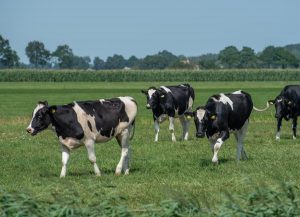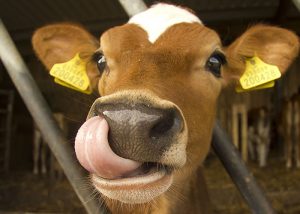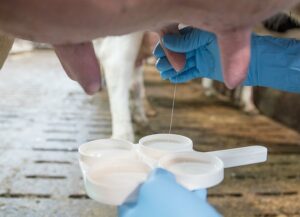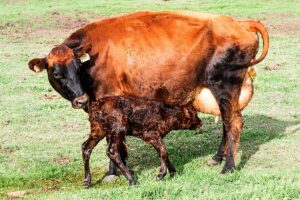Alvaro Garcia
It has been well documented that pre-weaned calves raised during summer have reduced gains. The reasons are multifactorial and include pre- and postnatal heat stress, flies, and wet bedding result of rainfall. Heat stress seems to be the main culprit however, with mechanisms to increase cooling (i.e. respiratory and cutaneous evaporative cooling) triggered when ambient temperatures exceed 20 °C. These mechanisms use energy and result in more energy for maintenance and less energy available for growth.
To make matter worse, starter intake is reduced at higher temperatures with less energy available for growth. It has been demonstrated that first lactation productivity is affected by heifer growth as calves. In addition, there are also effects on the calf’s immunity and disease with post-weaned calves on higher planes of nutrition displaying stronger resistance to disease.
A 2020 experiment looked at the effect of milk replacer feeding on performance and metabolism of pre-weaned calves during summer. Three-day old calves were assigned to 1 of 3 treatments:
- Control; CON; 0.55 kg of dry matter (DM) milk replacer/d with 20% protein and 20% fat.
- Intermediate; IN; 0.66 kg DM replacer/d with 26% protein and 17% fat.
- High; HG; 0.77 kg DM replacer/d with 26% protein and 17% fat.
Milk replacer had 12.5% solids and was offered twice/d until day 42. Thereafter it was fed only once/d to reduce intake by 50%. Calves were weaned at day 49 and kept in hutches until day 56 with starter ration and water offered ad libitum. Respiration rate and rectal temperatures were determined 3 times/week. Body weights were measured at 5 points during the trial. Plasma was collected to analyze for glucose, β-hydroxybutyrate, triglycerides, non-esterified fatty acids, urea nitrogen, and insulin. During the experiment, average ambient temperatures and relative humidity were 25.4 ± 4.0°C and 79.2 ± 16.3%, respectively.
Calves on the HG diet had greater fecal scores during the first 4 weeks of life and higher incidence of diarrhea compared with calves on CON, with intermediate values for IN calves. During week 2, calves in all diets had similar replacer intake. From weeks 3 to 7 however, calves on HG consumed more replacer than those in CON, with being IN intermediate. From weeks 4 to 6 calves in the HG diet ate more fat compared to IN and CON which were similar. As a result, from weeks 3 to 6 calves in HG consumed more metabolizable energy but only compared to CON, the energy intake of IN calves was intermediate. Body weights were not different for calves fed HG and IN at 42, 49, and 56 days. Calves in these two treatments however, weighed more than CON, had greater heart girth, and hip height, but again, no differences between them. By day 28 and through 56, calves fed HG and IN were also taller and had greater gain/intake than CON, and no differences between them. No differences were observed between treatments or interactions for plasma glucose, non-esterified fatty acids, β-hydroxybutyrate, and triglycerides. Plasma insulin concentrations were higher for HG, intermediate for IN and lowest for CON. Plasma glucose concentration was not influenced by replacement intake but insulin concentration increased at higher feeding rates.
Calves in this trial were under heat stress conditions both in the hutch and outside. Calves fed more milk relative to control had increased incidence of scours, which suggests a disturbance of digestion. On the other treatments, replacer intake reached the expected amounts only after 4 weeks of age, particularly in HG and IN calves. Calves fed the HG diet did not consume as much replacer as offered. It was speculated that feeding large quantities of milk twice/d under heat stress, delayed the emptying rate of the abomasum, and resulted in excessive gas production and bloating, limiting further intake. Accelerated replacer feeding (IN and HG) increased gain and growth when compared to CON, there were however no differences between the previous two accelerated feeding regimes. All calves had similar plasma concentrations of BHB during the experiment, which suggested similar rumen development.
What is important to point out is that feeding more replacer led to inefficient utilization of energy and nutrients. This was likely due to gastrointestinal hypertrophy result of the larger meal size and delayed emptying of the abomasum. Weight gains had the highest correlation with metabolizable energy intake, which is very important to consider when feeding calves under heat stress. This experiment demonstrated that summer feeding of an accelerated milk replacer (26:17 MR at 0.66 kg of DM/d twice daily) improved growth when compared against a conventional replacer (20:20 MR at 0.55 kg of DM/d).
Reference:
Rivas, R.O., Komori, G.H., Beihling, V.V., Marins, T.N., Bernard, J.K., Tao, S. 2020. Effects of milk replacer feeding levels on performance and metabolism of preweaned dairy calves during summer. Journal of dairy science. 103(1): 313-324.
© 2020 Dairy Knowledge Center, LLC. All Rights Reserved.











